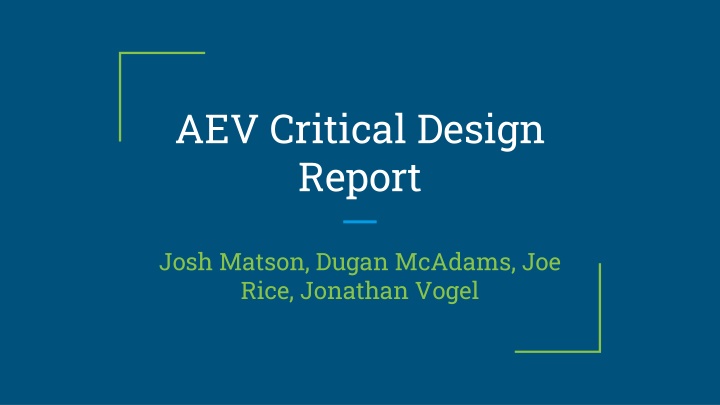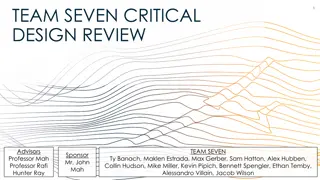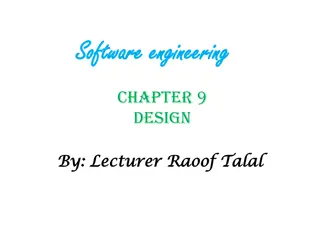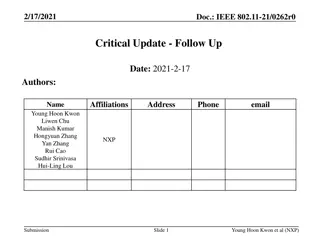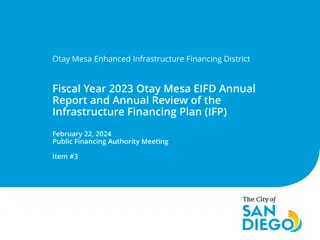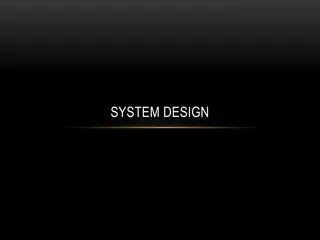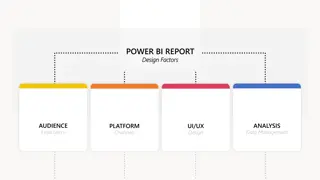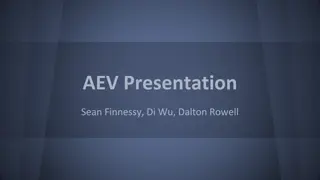AEV Critical Design Report Overview
In this critical design report, explore the process, components, and evaluation of an Advanced Electric Vehicle (AEV) by Josh Matson, Dugan McAdams, Joe Rice, and Jonathan Vogel. The report delves into primary and secondary designs, concept scoring, decision-making processes, energy efficiency considerations, and phases of the secondary design. Detailed images and data provide insights into the innovative design and evaluation stages of the AEV project.
Uploaded on Feb 21, 2025 | 0 Views
Download Presentation

Please find below an Image/Link to download the presentation.
The content on the website is provided AS IS for your information and personal use only. It may not be sold, licensed, or shared on other websites without obtaining consent from the author.If you encounter any issues during the download, it is possible that the publisher has removed the file from their server.
You are allowed to download the files provided on this website for personal or commercial use, subject to the condition that they are used lawfully. All files are the property of their respective owners.
The content on the website is provided AS IS for your information and personal use only. It may not be sold, licensed, or shared on other websites without obtaining consent from the author.
E N D
Presentation Transcript
AEV Critical Design Report Josh Matson, Dugan McAdams, Joe Rice, Jonathan Vogel
CDR Objective Overview Design Process Concept Scoring sheet Primary and Secondary designs Secondary Design Components Test Data Primary Design Components Modifications Test Data
CDR Objective Overview Final Design Evaluation: Physical components Software components Efficiency Potential improvements Final Evaluation
Design Process: Concept Scoring Matrix At a glance: Highest weighted items: efficiency, balance, volume, center of mass, speed All proposed concepts rate better than the Sample AEV Dugan McAdams design rated highest of the 5
Design Process, contd Decisions: Primary design: Tilt-rotor concept Propellers rotate to remain in pull configuration for both rounds around track Requires custom part, extra servo Secondary design: Robust concept Propellers fixed to one direction, unable to rotate No extra parts required
Secondary Design components Primary aspect: Simplicity and robustness Designed as a fallback design should the primary design fail Offers a platform that can undergo rapid trials Minimal moving parts, static design, easier to code
Secondary Design Phases (To Gate 1) Power usage by time spent traveling Power usage by distance traveled
Secondary Design Phases (To Gate 1) Phase Primary Command Duration/Dis tance Additional Commands Energy Used: 134.247 J 20.3 feet N/A 1(Green) Go Forward at 35% Mass: 0.131 kg 0.5 seconds N/A 2 (Red) All stop Energy/mass: 1024.786 J/kg 1 second N/A 3 (Orange/yellow) All Reverse 45% 5 seconds N/A 4 (Red) All stop
Primary Design components Primary aspect (Bread and butter): Tiltrotor capability Keep propellers in pull configuration for both track directions Utilize twin servos, mounted to custom airfoil Many moving components on AEV and variables in code
Primary Design Phases (To Caboose) Phase Primary Command Duration/Distance Additional Commands 1 (Red) Bring All motors to 35% 3 seconds N/A 2 (Magenta) All motors Ahead 35% To 20.3 feet N/A 3 (Blue) All Stop 0.5 seconds All Reverse 35% for 1 s. 4 (Green) All Stop 8 seconds All Ahead 0% 5 (Cyan) Bring All to 35% 3 seconds N/A 6 (Yellow) All Ahead 35% To 35 feet Bring All to 35% for 1 s. 7 (Burgundy) All Stop 1 second Rotate motors
Primary Design Phases (Return to Start) Phase Primary Command Duration/Distance Additional Commands 8 (Pink) Bring All motors to 45% 3 seconds N/A Energy Used: 509.837 J 9 (Purple) All Ahead 45% Back 20.3 feet N/A Mass: 0.29 kg 10 (Red 2) All Stop 0.5 seconds All Reverse 45% for 1 s. Energy/mass: 1758.059 J/kg 11 (Magenta 2) All Stop 7.5 sec All Ahead 0% 12 (Blue 2) Bring All to 45% 3 seconds N/A 13 (Green 2) All Ahead 45% Back 40.95 feet N/A 14 (Cyan 2) All Stop 0.5 seconds All Reverse 45% for 1 s.
Final Design: Concept and advantages Tiltrotor Requirements Purchase additional servo Design 3-D part to hold both servos Change code to adapt two servos Obstacles Initial 3-D part restricted motion of propellers Designing code to operate 2 servos Limited space, needed larger base
Final Design: Anticipated Advantages Several factors make the tiltrotor concept appear advantageous: Pull orientation would yield highest efficiency all the time With appropriate custom part, installation of motors would be simple Versatility of code would enable AEV to accomplish tasks beyond the MCR
Final Design Results: Physical AEV Physical takeaways: Custom part needed to be redesigned to allow motors to rotate Custom part secured servos adequately to AEV Center of mass resulted in unstable contact with test track (No recorded accidents); resolved Servo-servo mount connection and servo mount-motor mount connection both unstable (2 recorded accidents); unresolved Propeller-motor connection unstable (6+ recorded accidents); unresolved
Final Design Results: Software Software takeaways: Distance-based code proved more consistent compared to time-based track Code required extensive modification to use two servos Added servo rotation variables complicated AEV operation Had to rotate to clearance 180-degree rotation in Arduino program was over 180 degrees in real world Servo rotation allowed for a more dynamic strategy in MCR Rotating servos and active motors at moment of contact with trailer conserved momentum
Final Design Results: Efficiency Takeaways: Secondary design More energy efficient Primary Design Benefit of tiltrotor did not overcome its weight Energy/mass ratio lower despite tiltrotor s optimal propeller configuration 1024.786 J/kg to 1758.059 J/kg
Final Design: Potential Improvements 1.Develop servo-specific motor mounts to prevent loss of motors while in transit 2.Rewrite code to decrease motor run time (increase time coasting) 3.Develop axle system for motor rotation to simplify servo code and further minimize number of independent moving parts 4.Develop one-piece chassis to optimize center of mass, minimize AEV volume and number of free or unstable parts
Final Design: Evaluation Successful features: Tiltrotor capacity maintains pull configuration in both directions Increased variables (both hardware and software) grant greater versatility Hindrances: Design complexity (high number of independent hardware components) led to frequent breakdowns on the course Servo code modification and troubleshooting resulted in lost test time
Final Design: Evaluation Conclusion The ability to independently rotate motors offers potential to accomplish a wide number of tasks, going beyond the MCR; however, the number of independent factors required extensive time to test both hardware and software components. Furthermore, even with a solid test of components, it would most likely take more time to adapt the AEV for one specific task, such as the MCR. For the MCR, the versatility offered by this AEV does not offset the cost in time required to tune the AEV for the task, when other AEV designs can achieve the same efficiency with less testing time.
CDR Objective Review Design Process Primary and Secondary design choices chosen according to Concept Scoring matrix Secondary Design Primary aspect: Simple, robust design with minimal weight Primary Design Primary aspect: Tiltrotor design More massive than Secondary AEV Initial airfoil required replacement to allow motors to run in both directions Test Data indicates a higher energy than the secondary design from initial tests
CDR Objective Review Final Design Results: Hardware: Many moving components, resulted in long troubleshooting period Software: Code required modification; addition of more variables also resulted in long troubleshooting period Efficiency: AEV ran at high levels of energy; further testing could have yielded higher efficiency Evaluation: Tiltrotor design offered versatility for many tasks but required extensive testing time; time required to test was not worth the versatility with only one task to accomplish
